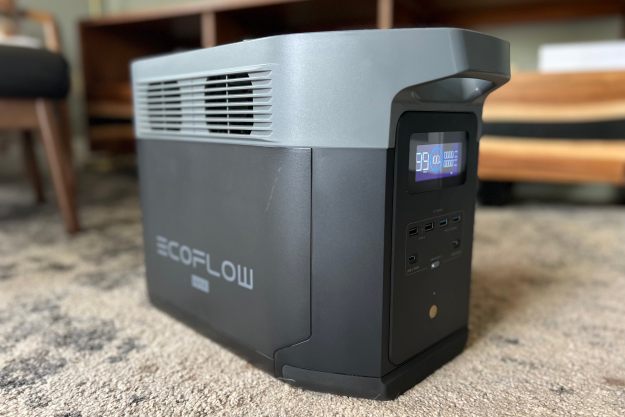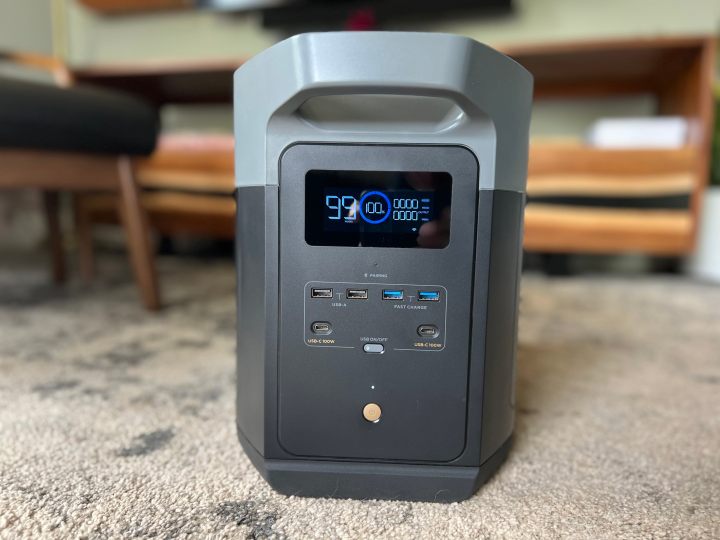
- Robust 2,400-watt output
- Best-in-class charging speeds
- Lighter than most LFP models
- Generous port selection
- Bluetooth and Wi-Fi support
- Extra battery ports
- Premium price
- No wheels
- Spotty support
You could be forgiven for eying the EcoFlow Delta 2 Max and wondering just what makes it any different from its well-respected predecessor, the EcoFlow Delta Max. They have the same design, the same 2kWh capacity, and the same ports. But there’s a big innovation beneath the familiar silver skin: This time the cells inside are lithium-iron phosphate.
Don’t let the jargon deter you: Whether you refer to these batteries by the acronym LFP or their chemical abbreviation LiFePO4, they’re safer, longer lasting, and less harmful to the earth. In the Delta 2 Max, EcoFlow uses them to bring the second generation of its gold-standard power station to another level.
Where it stands
EcoFlow’s taxonomy of similar-sounding names can be tough to decode, so let’s break it down: Delta means it’s for home backup and not traipsing around the woods, Max means it’s the big boy, and 2 – well, it’s the second generation. Power stations this size fall into the Goldilocks class: It’s much easier to bring with you than a modular system like the Bluetti AC500, and much more powerful than a super portable system like the EcoFlow River 2 Pro.
If you’re in the market for a solar generator with around 2kWh capacity, you’re cross-shopping with the respected $1,999 Anker 767 (now known as the Solix F2000), $2,499 Geneverse HomePower 2 Pro, and the $1,649 Jackery Explorer 2000 Pro. At $1,899, the Delta 2 Max finds itself in the middle of that price range but still manages to bring top-tier features.
All the ports you need, and then some
Like all of EcoFlow’s Delta series, the Delta 2 Max has a two-tone, silver-topped design that calls to mind an overgrown Duracell with handles. It’s luggable, but we wish it came with wheels (you’ll need to upgrade to the $3,700 Delta Pro to unlock this Flintstones technology).
EcoFlow uses three sides of the box for connections, which spreads out your cables more, but can make it tough to find the port you’re looking for. Putting the LCD display on the short side of the brick also makes it harder to tip back for a quick glance when it’s sitting on the floor.

When it comes to power, you get a healthy six AC outlets – more than any of its competitors. It also has all the expected USB-A and 100W USB-C ports for fast charging gadgets like laptops, then things get interesting.
Two proprietary ports on the back of the Delta 2 Max can be used to add extra batteries, allowing you to add up to 4kWh of capacity for a total of 6kWh. That’s a feature you’ll see in monster systems like the Bluetti AC500, but it’s rare to see in a generator this compact. These ports also let you power EcoFlow’s Wave 2 remote heat pump and air conditioner directly, without wasteful conversion of power to AC and back.

You also get a single cigarette lighter port, and two DC5521 ports, which give you another way to pull 12V DC power for accessories like fans, fridges, LED lights, and even some tech accessories like routers and security cameras. Besides freeing up AC ports, all of these devices will run more efficiently directly from DC.
Ironclad batteries
You’re already familiar with lithium-ion batteries: They’re in your phone, in your laptop, and if you own one, in your EV. The power they pack relative to their size and weight has made them the preferred option for decades, but their reliance on nickel and cobalt has also made them a bit of an environmental pariah in recent years. Just look in the comments section of an EV review for a lecture on the environmental and ethical toll of extracting these materials from the earth. Or ask Mr. Bean.
In contrast, LFP batteries use iron. Yup, the same stuff in your kitchen skillet. It’s easier to come by, less problematic to rip out of the earth, and has the added benefit of not causing fires hot enough to melt through pavement when things go wrong. Perhaps the biggest boon for you, though, is the lifespan. The previous-gen EcoFlow Max was rated for a lifespan of 800 cycles; the EcoFlow Delta 2 Max is rated to last 3,000. And it’s not kaput after that – it will just be reduced to 80% capacity. If you’re at all concerned about the longevity of your power station – and you should be for a device you spend over $2,000 on – LFP batteries represent a major upgrade.
The drawback typically comes as extra weight. Pound for pound, LFP batteries simply weigh more than their standard Li-ion peers. You can see that in the 87-pound Anker 767, which matches this power station in capacity. But somehow the EcoFlow Max 2 weighs just 50 pounds, a paltry 2-pound increase from the last generation. We’re not sure what black magic EcoFlow deployed to avoid tipping the scales, but every other LFP power station with this capacity weighs much more.
Can it live up to the specs?
EcoFlow rates the Delta 2 Max for 2,400 watts of output, which should theoretically match any standard 20-amp outlet in your home. A lot of devices surge past that temporarily though, and a lot of them live in the garage, so we ran the Delta 2 Max through the same gauntlet of tools that we’ve torture-tested its peers with: a table saw, air compressor, and miter saw.
Only the miter saw gave it a challenge, tripping it initially before powering on smoothly another dozen times. It’s clear this kind of power is right on the line of what the Delta 2 Max is up to delivering (to be fair, the same device sometimes trips my 20A home breakers). Since the table saw barely made it sweat, we doubled down and ran a 5HP shop vac in unison, which brought up right up to a sustained output of 2,253 watts without issue.

To really make the Delta 2 Max sweat, we broke out a space heater and heat gun. At a combined output of just under 2,400 watts, they pushed the Delta 2 Max to its theoretical max, and it rose to the occasion. While this test eventually shut down the Geneverse HomePower 2 Pro, which is rated 200 watts lower, the EcoFlow was able to sustain it for the long haul. In contrast, the Anker 767 initially allowed this combo to put out 2,700 watts but eventually ramped down to 2,100 watts after about a minute. So while every power station can stretch beyond its max rated output for a minute or two, the EcoFlow delivered the highest sustained output.
When it’s time to fuel up, EcoFlow claims the Delta 2 Max is the “world’s fastest” thanks to 1,800-watt AC charging plus 1,000 watts of solar charging – the latter part of which we’re going to ignore because nobody charges from solar and wall power at the same time. In real-life use, the Delta 2 Max pulled a steady 1,590 watts from the wall. While that’s 210 watts below its claimed 1,800W charge rate, it’s still faster than the 1,450-watt rate on the Geneverse, and the 1,390 watts on the Anker. World’s fastest recharging? Maybe not quite as fast as it says on the box, but it’s still best in class.
The solar option
If you want to charge the EcoFlow Delta 2 Max on solar power, it has two solar inputs that accommodate 500W apiece, for a total of 1,000W solar input. That matches the Anker 767 and bests the 800W input on the Geneverse HomePower Two Pro.
EcoFlow offers an array of different panels from 60W to 220W. We tested the system with its new 220W bifacial panels, which have the added benefit of collecting reflected light from behind. A clever zip-up case opens to reveal a reflective lining, which you can place the panels on to help them collect the most light. Using the soft case as a stand with carabiners seems brilliant at first, but it’s so fussy to set up we’d really prefer the more standard fold-out kickstand. In our admittedly nonscientific testing, they tended to generate more power (as a percentage of rated output) than Anker’s 200W 531 panels or Geneverse’s 160W AIR bifacial panels.

At $549 for 220W capacity, EcoFlow’s panels are competitively priced. The Geneverse panels mentioned above go for $489, but since they’re only rated at 160W capacity, EcoFlow’s cost less per watt. Anker doesn’t offer bifacial panels yet, and the panels it offers for $549 deliver 20W less rated output than EcoFlow’s.
Unlike all of its portable competitors, EcoFlow’s panels also use MC4 connectors – the same heavy-duty standard you’d find in residential solar. That means you could potentially use the cables included with this power station to charge from full-size panels, as long as they fall within the voltage specs.
App and support
While the display on this power station gives you most of the information you need, the EcoFlow app unlocks advanced features like setting minimum and maximum charge levels, setting units, and upgrading firmware. You can connect to it via Bluetooth or Wi-Fi, which is a handy way to stay connected both around the home and in the field. It’s easy to set up the first time and reliably reconnects without any fiddling.
Our only complaint was the in-app support chat. When we tried to get help with another EcoFlow device, support totally ghosted us. Reddit users report similar failures, which is disappointing. For the premium EcoFlow charges, we expect better support when things go wrong.
Pay more, get more
The EcoFlow Delta 2 Max puts out more power than its nearest competitors, charges faster, and despite the long-lasting LFP chemistry, weighs less. At $1,899, it’s also cheaper than all of its name-brand peers, short of the Jackery Explorer 2000 Pro. While that model comes close in many ways, its LFP cells mean it has a third of the cycle life as this EcoFlow. We can’t possibly recommend making that choice to save $350.
This one is a no-brainer: If you’re buying for the long haul, there’s no better option than the EcoFlow Delta 2 Max. With its long-life cells, expandability, and wide selection of ports, this could easily be a device that’s still rescuing you from blackouts a decade from now.
Editors' Recommendations
- EcoFlow launches Delta 2 Max solar generator for home emergencies and outdoor adventures
- EcoFlow’s Wave portable AC arrives just in time for summer






